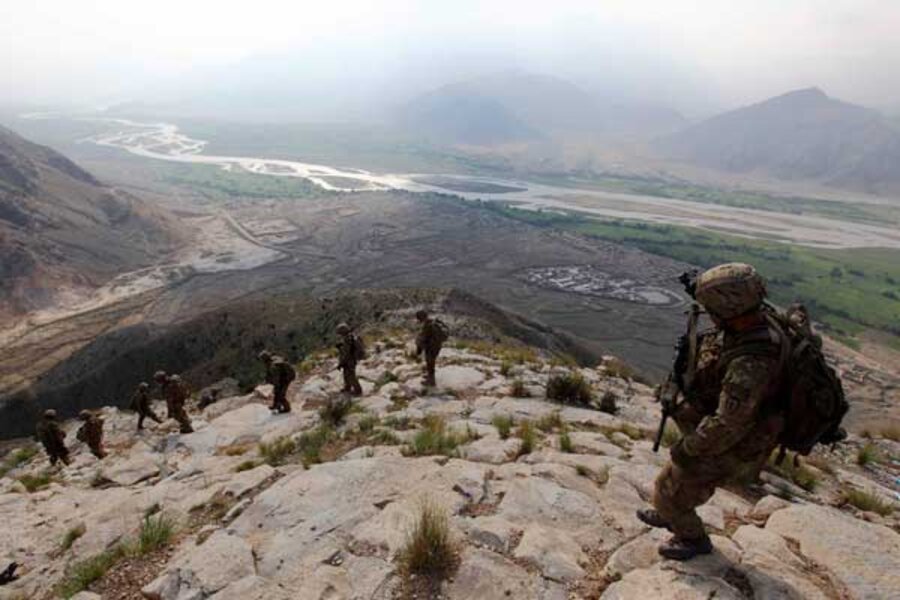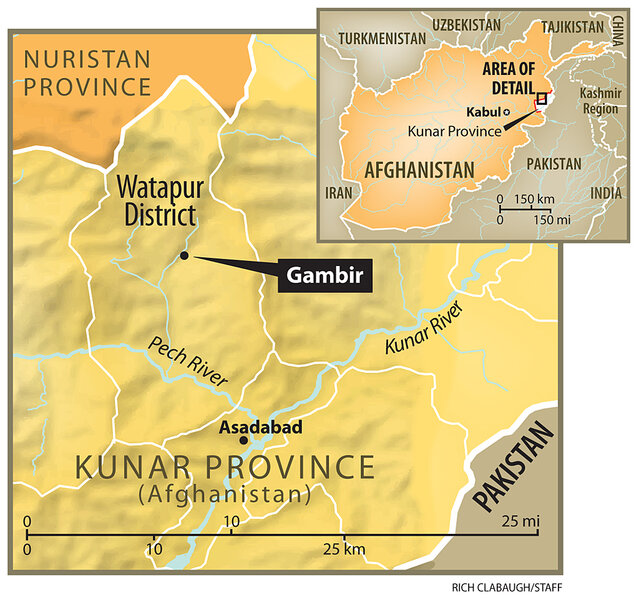Battle for Afghanistan's Gambir Jungle: Into the 'Valley of Death'
Loading...
| Kunar, Afghanistan
[To read the first installment of this series, please click here.]
By late June, the US troops of Operation Hammer Down were ready to go, and they had terrorist training camps of the Pech River Valley in their sights.
The Pech Valley is the face of the war in eastern Afghanistan: remote, treacherous, and home to the legendary veterans of the battles against Soviet occupation in the 1980s. It has been called the "Valley of Death."
The region is a magnet for Taliban fighters who have sanctuary across the border in Pakistan, as well as home to local sympathizers who offer training camp space in their backyards to foreign fighters, according to US intelligence assessments. The camps bring money and prestige to organizers and their clans.
Operation Hammer Down was to target the training camps in one of the Pech's adjoining valleys – the Watapur, which includes the pine forests and cave networks of what US commanders nickname the "Gambir Jungle." B Company of the 2nd Battalion, 3rd Brigade, 25th Infantry Division got the call.
In the Gambir Jungle, Sunday, June 25 arrived with B Company's 1st Platoon on the verge of its target. According to the 1st Platoon's global-positioning systems, the soldiers were 400 yards from Gambir – a village of mud huts, called kulats, surrounded by training camps.
First Platoon had been dropped off on a high ridgeline by helicopter just before midnight on June 24 and had taken eight hours to reach this point, each man carrying at least 60 pounds of gear down the rutted, steep slope.
"You can't just stroll down the mountain," says Sgt. Elwyn Lovelace of the 1st Platoon. "You're trying not to fall or roll down the mountain."
As day broke, the platoon was poised on the edge of a gulch too deep to climb down and too wide to leap across. But it wasn't long before some Afghan National Army soldiers with the US forces found a natural land bridge.
As the US troops crossed it, a firefight began – one that would last four days.
In the first 30 hours on the ground in Gambir, nearly half of the roughly 40 men in 1st Platoon would be wounded, and three would be killed, including its commander.
By the end, the 1st would be "down to 15 guys," a soldier says. "We were what they call 'combat ineffective.' "
The initial firefight, however, was brief and, some thought, final. Troops had located the enemy in a nearby cave and the shooting had stopped.
But then the attacks began in earnest. Never before had Lovelace wondered, "Am I going to make it back today?" Yet in the hours to come, he says, it was a question he would ask himself repeatedly.
Some insurgent forces were shooting from beneath earth-colored blankets that masked their heat signatures from US Apache gunships. Others had begun to flank US forces in a classic L-shaped ambush, maneuvering up around the platoon.
Their fire was effective and devastatingly accurate. "Most of the guys who got shot got shot in the neck, face...," says Spc. Derrick Dickerson of 1st Platoon, his voice trailing off.
As the ambush of June 25 wore on, the toll on the 1st mounted. A company commander on the mission broke his ankle and had to be flown out. An Afghan Army soldier had been shot in the neck, and two other American soldiers had been shot in the neck and lip. And when the commander of the 1st Platoon, 1st Lt. Dmitri Del Castillo, went to higher ground to organize a medical evacuation, he was shot in the neck, too.
"Everybody's yelling, 'The LT is down!' " Dickerson says of the fatal shot. "It all happened so fast."
Nearby, in the gulch that first stopped the Americans' progress, another leader in the platoon, Staff Sgt. Nigel Kelly, was trying to load the body of an Afghan interpreter who had been killed onto a sling when he was shot in the hip.
Dickerson and a few fellow soldiers urged Kelly to move down with them into the gulch. Once there, however, they were stuck as they waited for a medevac. One helicopter tried to land but was chased away by rocket-propelled grenade fire. US attack aircraft couldn't fire on insurgents for fear of hitting their own soldiers, who were dangerously close. Despite the seriousness of Kelly's injuries, the only option was to wait.
"We couldn't move up that hill because we had no cover," says Dickerson. "We played dead and waited until dark, because that was the only option."
Dark was more than three hours away.
• To see a video of the battle recorded by Sergeant Lovelace working with the 1st Platoon, click here.
Battle for the Gambir Jungle:
Part 1, Tuesday: Soldiers' tales of an epic battle
Part 2, Wednesday: Into the 'Valley of Death'
Part 3, Thursday: First Platoon's 'last stand'
Part 4, Friday: A race against daybreak
Part 5, Saturday: What was it all for?






